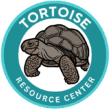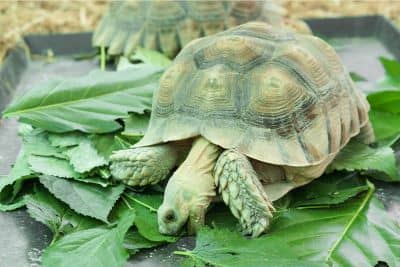Knowing which tortoise safe plants you can use in your enclosure is absolutely essential, yet it’s one of the most overlooked aspects of tortoise care. Live plants are a vital part of any tortoise’s natural habitat, and the more you can replicate that natural environment in your own enclosures, the better your tortoise’s quality of life will be.
Here’s what makes tortoise safe plants so important: your tortoise will eat almost anything green that’s within reach. They don’t instinctively know which plants are toxic and which are safe. A beautiful landscape plant that seems harmless to you could contain compounds that cause organ failure, neurological damage, or death in tortoises! One mistake—planting the wrong shrub near their enclosure or letting them access your garden—can be fatal.
The problem is that most plant guides are written for general gardening or livestock, not specifically for tortoises. A plant listed as “safe for pets” might be fine for dogs but toxic to reptiles. A landscape plant that seems too tough for your tortoise to eat might have fallen leaves they’ll consume. Without a comprehensive understanding of which tortoise safe plants are truly appropriate, you’re essentially hoping nothing bad happens.
This guide will walk you through everything you need to know about tortoise safe plants—from the grasses that should fill their enclosures to the flowers they can safely munch on, the shrubs and trees that provide edible variety, and critically, the common toxic plants that must be kept far away from your tortoise’s habitat.
- Why Tortoise Safe Plants Matter More Than You Think
- Benefits of Tortoise Safe Plants in Their Diet
- Grasses and Hays: The Foundation Plants
- Flowers and Herbs: Beautiful and Edible
- Shrubs and Trees: Hardier Tortoise Safe Plants
- Common Toxic Plants That Are Never Safe
- Incorporating Tortoise Safe Plants into Habitats
- Maintaining Plant Health in Tortoise Habitats
- Species-Specific Considerations
- Ready to Create a Safe, Natural Habitat?
- Citations
Why Tortoise Safe Plants Matter More Than You Think
You don’t need a green thumb to create a safe, beautiful, plant-filled tortoise enclosure. But you absolutely need to know which tortoise safe plants are appropriate and which will harm or kill your pet. This isn’t about creating Instagram-worthy habitats—it’s about preventing poisonings that happen far more often than most keepers realize.
Tortoises are opportunistic feeders and natural foragers, often able to survive long periods without food by grazing whenever they encounter edible vegetation. Having access to living plant material allows your pet tortoise to engage in that natural behavior beyond routine meal times. This enrichment is valuable for their physical and mental health.
In my experience, tortoises with diverse enclosures filled with appropriate tortoise safe plants are more eager to explore and engage with their surroundings. They exhibit more natural behaviors, get more exercise, and seem generally more content than tortoises kept in barren enclosures with only delivered meals.
Another benefit of adding live tortoise safe plants to enclosures is aesthetic appeal. Whether indoors or outside, there’s nothing quite like a tortoise habitat that blends beautifully into the surrounding landscape or room design. When done correctly with appropriate species, you create a space that’s both functional for your tortoise and attractive to human observers.
Benefits of Tortoise Safe Plants in Their Diet
Your tortoise’s diet should consist almost entirely of fresh produce, and one of the best ways to fulfill that need is by creating an edible landscape they can roam through naturally. This approach offers multiple advantages over simply delivering food to a feeding dish.
When you fill an enclosure with appropriate tortoise safe plants, your tortoise can graze throughout the day rather than eating only during scheduled feeding times. This mimics their natural feeding patterns where they walk slowly while constantly nibbling on available vegetation. The continuous grazing pattern is healthier for their digestive systems than consuming large meals then sitting idle for days.
Growing tortoise safe plants directly in the enclosure also provides behavioral enrichment. Tortoises that can forage for their own food are mentally stimulated by the search-and-find aspect of feeding. They make choices about what to eat and when, exercise more as they move around foraging, and engage in species-appropriate behaviors that improve overall wellbeing.
From a practical standpoint, established plantings of tortoise safe plants can reduce your daily maintenance time and food costs. Once plants are established, they provide ongoing nutrition without daily trips to the grocery store. You still need to supplement with additional foods and ensure nutritional balance, but having a base of growing vegetation simplifies daily care.
Grasses and Hays: The Foundation Plants
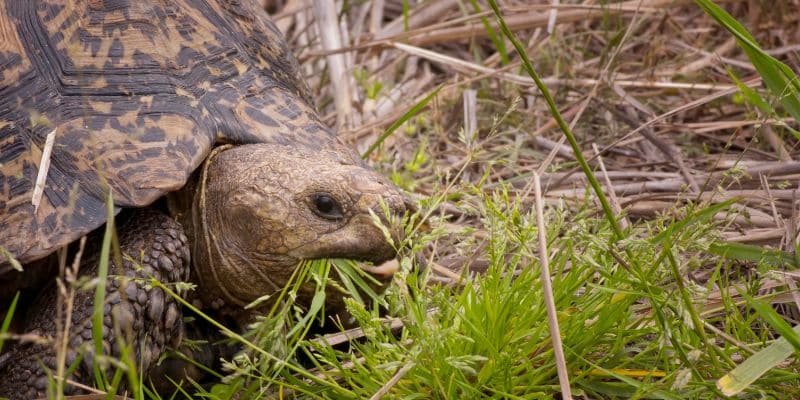
Grasses and hays should make up the bulk of most domestic tortoise diets, making them the most important category of tortoise safe plants. These plants are naturally high in fiber, low in fat and protein, and perfect for grazing on for hours at a time—exactly what most tortoise species need.
Safe grass species for tortoises: Bamboo (Bambusa vulgaris) can be offered in moderation. Barley grass (Hordeum spp.) is excellent for grazing. Barnyard grass (Echinochloa spp.) grows well in many climates. Bermuda grass (Cynodon dactylon) is one of the most popular and widely available options. Big Bluestem (Andropogon gerardi) is a native prairie grass that works well. Buffalo grass (Bouteloua dactyloides) is drought-resistant and appropriate. Crabgrass (Digitaria spp.) despite being considered a weed, is actually safe and nutritious.
Additional safe grasses: Fescue (Festuca spp.) comes in many varieties suitable for tortoises. Oat grass (Avena spp.) provides good nutrition. Orchard grass (Dactylis glomerata) is widely recommended and available. Pampas grass (Cortaderia selloana) works for larger enclosures. Quackgrass (Elymus repens) is safe despite being invasive. Rye grass (Lolium perenne) is commonly used in tortoise habitats. St. Augustine grass (Stenotaphrum secundatum) grows well in warm climates. Timothy grass (Phleum pratense) is probably the most recommended for tortoises. Wheat grass (Triticum spp.) is safe and nutritious.
When planning grass plantings, consider your climate and which species will thrive naturally in your area. Native grasses or those adapted to your region will require less maintenance and provide better year-round coverage. Avoid treating any grasses with pesticides, herbicides, or fertilizers that aren’t certified safe for reptiles.
For growing tortoises, ensuring they have constant access to appropriate grasses while maintaining proper mineral balance is crucial. Our Baby Sulcata Superfood Powder complements grass-based diets perfectly, providing the additional nutrients young tortoises need without requiring you to perfectly balance dozens of different plant species.
Flowers and Herbs: Beautiful and Edible
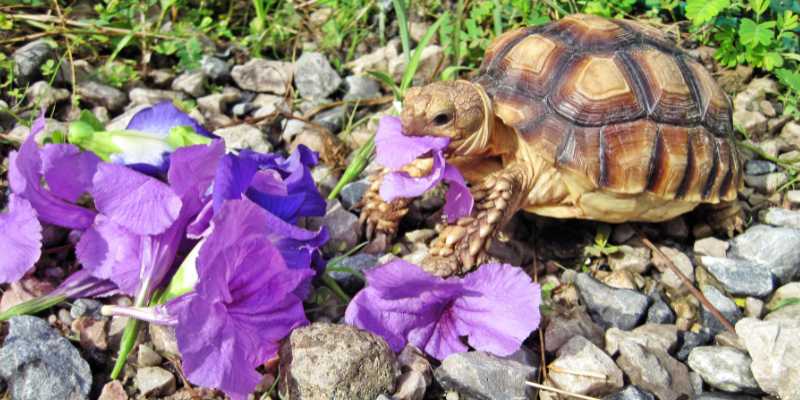
Why not design a landscape both you and your tortoise can enjoy? These flowering plants and herbs are all confirmed tortoise safe plants that add visual appeal while providing edible variety.
Freely available flowers: African Violet (Saintpaulia ionantha) is completely safe and attractive. Aster (Aster spp.) provides beautiful blooms tortoises can eat. Astilbe (Astilbe spp.) offers unique foliage and flowers. Bee Balm (Monarda spp.) attracts pollinators and feeds tortoises. Bellflower (Campanula spp.) produces lovely edible flowers. Coleus (Plectranthus spp., Solenostemon spp.) has colorful foliage. Coneflower (Echinacea spp.) is both beautiful and safe. Coreopsis (Coreopsis spp.) produces abundant flowers. Hollyhock (Alcea rosea) provides tall, impressive blooms. Ice Plant (Mesembryanthemum criniflorum) is succulent and safe.
Herbs safe for tortoises: Marjoram (Origanum majorana) is completely safe. Mint (Mentha spp.) is safe except for Peppermint (Mentha x piperita) which should be avoided. Oregano (Origanum vulgare) can be planted freely. Thyme (Thymus spp.) is excellent for tortoise enclosures. These herbs add wonderful variety while being among the safest tortoise safe plants.
Flowers and herbs to use in moderation: Some tortoise safe plants should only be fed occasionally rather than as unlimited forage. Alyssum (Alyssum spp.) is safe in moderation. Basil (Ocimum basilicum) should be limited. Begonia (Begonia spp.) is fine occasionally. Bugleweed (Ajuga spp.) in moderation. Chrysanthemum (Chrysanthemum spp.) occasionally. Cilantro (Coriandrum sativum) sparingly. Coral Bells (Heuchera spp.) in moderation. Cosmos (Cosmos spp.) occasionally. Creeping Jenny (Lysimachia nummularia) limited amounts.
Additional moderate-use flowers: Dahlia (Dahlia spp.) in moderation. Daylily (Hemerocallis spp.) occasionally—note these are different from true lilies which are toxic. Gerber Daisy (Gerbera spp.) in moderation. Hosta (Hosta spp.) occasionally. Jasmine (Jasminum spp.) limited amounts. Lavender (Lavandula spp.) in moderation. Lemon Balm (Melissa officinalis) occasionally. Nasturtium (Tropaeolum majus) in moderation. Pansy (Viola spp.) can be freely eaten. Perennial Geranium (Geranium spp.) is safe. Petunia (Petunia spp.) in moderation. Phlox (Phlox spp.) occasionally. Pot Marigold (Calendula spp.) is safe. Rose (Rosa spp.) in moderation. Sage (Salvia spp.) occasionally. Snapdragon (Antirrhinum spp.) is safe. Spiderwort (Tradescantia spp.) in moderation. Sunflower (Helianthus annuus) occasionally. Violet (Viola spp.) freely available. Zinnia (Zinnia spp.) is completely safe.
Plants marked “in moderation” are good choices for areas outside the main enclosure where your tortoise may occasionally spend supervised time. Others can be planted inside the enclosure or right along its perimeter where tortoises have constant access.
Shrubs and Trees: Hardier Tortoise Safe Plants
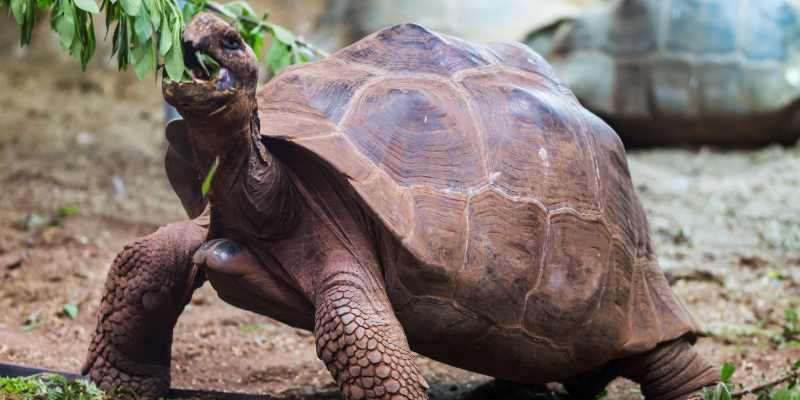
Many tortoises enjoy munching on hardier foliage from shrubs and trees, making these excellent additions to larger outdoor enclosures. These tortoise safe plants have leaves, flowers, and other parts that can be offered for variety. Always avoid feeding plant materials that are too tough or have dangerous obstacles like thorns.
Fruit trees (use in moderation): Apple and Crabapple (Malus spp.) trees provide safe leaves and flowers. Apricot, Cherry, Peach, and Plum (Prunus spp.) offer edible leaves but avoid giving access to pits. Banana (Musa spp.) plants have large, safe leaves. Mulberry (Morus spp.) trees are excellent tortoise safe plants. Olive (Olea europaea) trees can be used carefully. Raspberry and Blackberry (Rubus spp.) provide leaves and fruit but watch for thorns.
Ornamental shrubs and trees: Barberry (Berberis spp.) can be used in moderation—careful of thorns. Beech (Fagus spp.) offers safe leaves. Birch (Betula spp.) is appropriate. Bougainvillea (Bougainvillea spp.) in moderation. Butterfly Bush (Buddleia spp.) occasionally. Camellia (Camellia japonica) in moderation. Cinquefoil (Potentilla fruticosa) occasionally. Crape Myrtle (Lagerstroemia indica) in moderation. Desert Willow (Chilopsis linearis) is excellent for desert species. Elm (Ulmus spp.) is completely safe.
Additional safe shrubs: Flowering Maple (Abutilon spp.) is safe. Forsythia (Forsythia spp.) in moderation. Fuchsia (Fuchsia spp.) occasionally. Grape Vine (Vitis spp.) in moderation. Hebe (Hebe spp.) is safe. Hibiscus (Hibiscus rosa-sinensis, H. syriacus) is one of the best tortoise safe plants available. Jacaranda (Jacaranda spp.) is appropriate. Lilac (Syringa spp.) can be used. Magnolia (Magnolia spp.) in moderation. Maple (Acer spp.) occasionally—avoid red maples. Mexican Orange Blossom (Choisya ternata) in moderation—do not confuse with Mock Orange (Philadelphus coronarius) which should be avoided. Rose of Sharon (Cistus spp.) in moderation. Spirea (Spiraea spp.) is safe. Weigela (Weigela spp.) in moderation.
When selecting shrubs and trees as tortoise safe plants, consider your tortoise’s size and strength. Large tortoises can damage or uproot smaller plants, while tiny tortoises may struggle with tough leaves from large trees.
Common Toxic Plants That Are Never Safe
In addition to the recommended tortoise safe plants above, you need to know which common plants are definitively toxic to tortoises. This list only scratches the surface—you should research any plant you’re unfamiliar with before giving your tortoise access.
Black-Eyed Susan (Rudbeckia spp.): This common perennial must be kept away from tortoise habitats. It’s toxic to grazing livestock and has similar effects on reptiles.
Daisy (Bellis perennis): Mildly toxic and should not be fed or grown within tortoise enclosures. Note that this refers to common daisies—other “daisy” named plants like Gerber Daisies are safe.
Morning Glory (Convolvulaceae family): This family includes several ornamental and weedy vining plants. While some morning glories may be safe in small quantities, it’s best to avoid them altogether given the difficulty in correctly identifying safe versus toxic varieties.
Oleander (Nerium oleander): A popular landscape shrub in many climates, Oleander is infamous for its poisonous plant parts. All portions are highly toxic and should be kept far away from any tortoise habitat. Even small amounts can be fatal.
Periwinkle (Vinca spp.): Plants belonging to the genus Vinca are considered mildly toxic to tortoises and other grazing animals. These flowering vines spread vigorously, so avoid them in your garden altogether to be safe.
Leadwort (Plumbago spp.): Some wild tortoises eat leadwort plants in natural habitats, but the sap causes skin irritation and indigestion. Keep away from pet tortoises.
Rhubarb (Rheum spp.): Commonly grown for its edible stems in human cooking, all other parts of the rhubarb plant contain high levels of oxalates which are toxic to tortoises and most other pets. Never plant near tortoise enclosures.
Hydrangea (Hydrangea spp.): According to The American College of Emergency Physicians, these shrubs contain a toxic compound called cyanogenic glycoside. Keep completely away from tortoises and their enclosures.
Lily (Lilium spp.): True lilies are very toxic to many animals. This includes Asiatic lilies, tiger lilies, and other common varieties. Daylilies (Hemerocallis spp.) are safe alternatives and among verified tortoise safe plants.
Peony (Paeonia spp.): All parts of the peony plant are toxic. The exact effect on tortoises isn’t fully documented, but avoid peonies near tortoise habitats entirely.
Oak (Quercus spp.): Oak trees contain tannic acid which is toxic to tortoises. The acid is most concentrated in young leaves and acorns. Avoid placing tortoise enclosures near mature oak trees, and prevent access to fallen acorns.
Are You Starving Your Tortoise?
Save 10% on premium tortoise food and supplements from Tortoise Resource Center on Amazon now using code BUYNOWGET10

Sulcata Vitamin & Mineral Topper Supplement
30-Day Supply | 2 oz (56 g)
$24.99
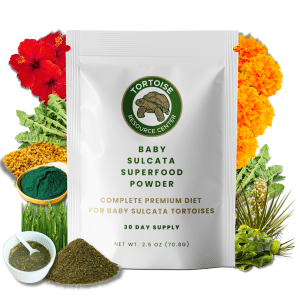
Baby Sulcata Tortoise Superfood Powder
30-Day Supply | 2.5 oz (70.8 g) Bag
$24.99
Incorporating Tortoise Safe Plants into Habitats
The hardest part of adding live tortoise safe plants to habitats is finding species that match your pet’s specific needs. A tortoise that requires high humidity like a red-footed tortoise won’t thrive in an enclosure filled with desert cacti, and vice versa. Match plant selection to your tortoise species’ natural habitat requirements.
If you’re designing an outdoor enclosure, account for your local climate. Native plants or those from similar climates will be easiest to grow and maintain. They’ll be naturally adapted to your area’s temperature ranges, rainfall patterns, and soil conditions, requiring less intervention to keep healthy.
When adding live tortoise safe plants to indoor enclosures, I highly recommend using small pots rather than planting directly into the habitat’s substrate. This extra step makes maintaining both plants and the surrounding enclosure much easier. You can remove plants for watering or treatment without disturbing the entire habitat, and can rotate plants in and out as they’re eaten or need recovery time.
Finding quality tortoise safe plants that haven’t been treated with pesticides can be challenging. These chemicals are harmful to tortoises even in small amounts. Connect with organic nurseries and greenhouses in your area who should be able to source safe plants or at least confirm what treatments their plants have received. When in doubt, purchase untreated plants and quarantine them for several weeks before introducing them to tortoise enclosures.
Even with appropriate tortoise safe plants well-established in enclosures, you’ll still need to supplement diet with additional foods and minerals to ensure complete nutrition. Our Vitamin and Mineral Topper helps fill nutritional gaps that may exist even in plant-rich habitats, providing comprehensive mineral support that’s difficult to achieve through plants alone.
Maintaining Plant Health in Tortoise Habitats
Keep in mind that you can’t maintain tortoise safe plants the same way you would those in regular lawns or gardens. Standard fertilizers, pesticides, and treatments are often toxic to reptiles even if safe for the plants themselves.
If you must apply fertilizer or any treatment to plants in tortoise habitats, opt only for natural formulas certified as safe for reptiles. Read labels carefully and when in doubt, skip the treatment. Remember that “organic” doesn’t automatically equal safe for tortoises—some organic pest controls use compounds harmful to reptiles.
Clean up damaged or dying plant material promptly, just as you would remove old tortoise food. Decaying plant material becomes a haven for pests, bacteria, and fungi that can cause health problems. Regular habitat maintenance includes removing dead leaves, spent flowers, and damaged plant parts.
Monitor plants—especially new additions—for signs of pests or disease. While these issues probably won’t directly affect your tortoise, it’s best to catch and treat problems early for both the plant’s health and your pet’s safety. Some pest infestations attract insects that can bother tortoises, while diseased plants may produce compounds that weren’t present when healthy.
Consider rotation systems for tortoise safe plants in smaller enclosures. Have backup plants growing outside the habitat that can be swapped in when enclosure plants are heavily grazed and need recovery time. This prevents complete destruction of plantings while maintaining a green, natural habitat.
Species-Specific Considerations
Different tortoise species have different relationships with plants based on their natural habitats. What works as tortoise safe plants for one species might not be ideal for another.
Desert species like sulcatas and Russian tortoises do best with drought-tolerant grasses and minimal flowering plants. Focus on hardy grass species that can withstand both grazing and arid conditions. Avoid water-loving plants that require frequent irrigation.
Forest species like red-footed and yellow-footed tortoises appreciate more varied plantings including broad-leafed plants, ferns, and flowers. They come from environments with diverse vegetation and benefit from that variety in captivity.
Mediterranean species like Hermann’s, Greek, and Marginated tortoises need plantings that reflect their seasonal environments. Include both drought-tolerant and moisture-loving tortoise safe plants to accommodate seasonal changes in their native habitats.
Research your specific tortoise species’ natural habitat and try to replicate the types of vegetation they’d encounter in the wild. This ensures both physical and psychological wellbeing.
Ready to Create a Safe, Natural Habitat?
Understanding tortoise safe plants is fundamental to creating habitats that support natural behaviors while preventing tragic poisonings. The difference between a barren enclosure and a thriving planted habitat is dramatic—not just aesthetically, but in terms of your tortoise’s quality of life and engagement with their environment.
By focusing on verified tortoise safe plants and strictly avoiding toxic species, you create spaces where your tortoise can safely forage, graze, and engage in species-appropriate behaviors. The time invested in learning which plants are appropriate pays dividends for decades as your tortoise thrives in a naturalistic environment.
Want even more detailed guidance on creating the perfect planted habitat for your specific tortoise species? Sign up for our free bonus pack and get instant access to species-specific plant lists, habitat design templates, seasonal planting guides, and toxic plant identification tools. Plus you’ll receive feeding schedules, growth tracking charts, and expert tips for creating naturalistic environments that keep tortoises healthy and engaged.
Your tortoise deserves a habitat that doesn’t just keep them alive, but allows them to truly thrive with access to appropriate tortoise safe plants they can safely enjoy for their entire long life.
Citations
The Tortoise Table – Plant Database Arizona Exotic Animal Hospital – Edible Plants and Weeds for Tortoises and Land Turtles Tortoise Group – Plants List
